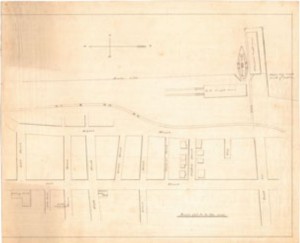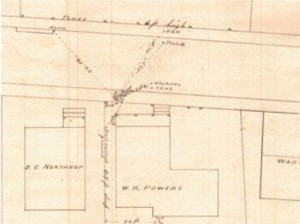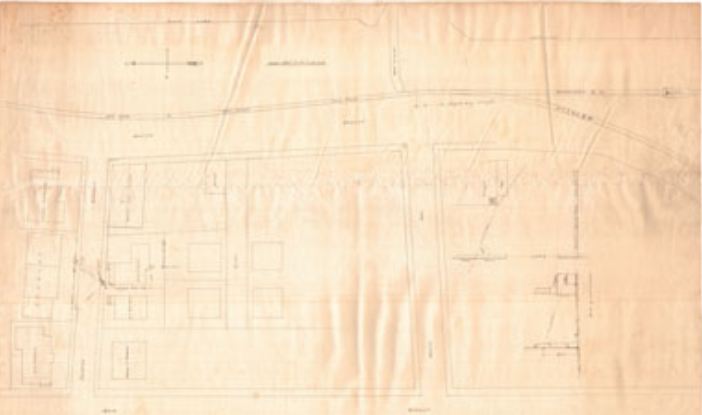By Tasha Caswell for Your Public Media
The “murder map” is, at first glance, unremarkable—hand-drawn, it depicts a section of an unnamed town, one that contained various houses and businesses, was near the water, and had railroad tracks running through it. Things get decidedly more compelling when it becomes clear that it depicts the scene of a sensational crime in Bridgeport, Connecticut.

Map of a portion of Bridgeport. Drawing by an unknown draftsman, 1872. Colvocoresses was on his way to the steamboat dock when he was killed – Connecticut Historical Society
Captain George M. Colvocoresses, naval officer, Pacific explorer, Civil War hero, and survivor of kidnapping, yellow fever, and various wars, was killed in Bridgeport, Connecticut, in 1872. Colvocoresses, or “Colvos,” as he was known to friends, was born in Chios, Greece, in 1816. At the age of six, George was kidnapped and enslaved by the Turks in the Greek War for Independence. Ransomed by his father, the child was sent to the United States, where he lived with Captain Alden Partridge and his family in Vermont. George was educated at the local military academy (now Norwich University) and eventually joined the Navy, with which he enjoyed a distinguished career.
After retiring from the Navy as a captain in 1867, he returned to family life in Litchfield, Connecticut, where he lived with his second wife. On June 3, 1872, George was traveling to New York City, first on the Shepaug Valley Railroad to Hawleyville, then the Housatonic Railroad to Bridgeport, from which point he was to catch the steamer to New York at 11:00 pm. He carried with him an umbrella, $8,000 in cash within a carpet bag, and a cane that contained a sword. He stopped into the Sterling House seeking supper but the kitchen was closed and he went to Ward’s Restaurant instead. After revisiting the Sterling House to return a hotel key he had forgotten to give back the previous week, he then stopped at Wheeler’s drug store to purchase paper and two envelopes. George left the drug store at 10:35 pm and headed toward the dock. He never made it—he was intercepted along Clinton Street and shot with a pistol.
Despite 19th-century Crime Scene Investigation, Bridgeport Case Remains Unsolved

Site of the Murder of George M. Colvocoresses, Bridgeport, Connecticut. Drawing by an unknown draftsman, 1872. This detail of the “murder map” shows where Colvocoresses’s body was found – Connecticut Historical Society
The map shows the location of his prone body on the sidewalk of Clinton Street next to his cane and umbrella; across the street are a pistol and powder horn, while the empty carpet bag is some distance away, near the dock. At the bottom of the map are two projections of the trajectory of the bullet, one from the side and one from the top. There is a second map, also hand-drawn, that depicts more of Bridgeport, showing the businesses Colvos patronized on the night of his death, the route he was taking when he was killed, and the steamboat he should have boarded. The only confirmation that this map, which does not show the location of the body or the trajectory of the bullet, is connected to the murder is the inscription at the bottom right, which reads, “Carpet bag 300 yards south of South Ave.”
George’s killer was never caught, and though numerous theories were floated over the years to explain what happened that night, the crime was never solved. Along with the $8,000 in cash, another $80,000 in stocks was presumed to have been stolen. The money was never recovered and no one was ever charged with killing the captain. The secret of who killed a war hero, naval officer, explorer, and survivor most likely died with the person who committed the crime.
The “murder map” is one of 800 maps in the collections of the Connecticut Historical Society that are being digitized and added to CHS’s online database, with generous support from Connecticut Humanities.
Tasha Caswell is the Thorne-McKenna Curatorial Assistant at the Connecticut Historical Society
© Connecticut Public Broadcasting Network and Connecticut Historical Society. All rights reserved. This article originally appeared on Your Public Media.
Note: ConnecticutHistory.org does not edit content originally published on another platform and therefore does not update any instances of outdated content or language.









